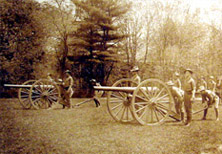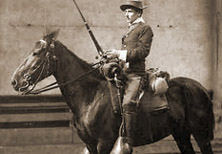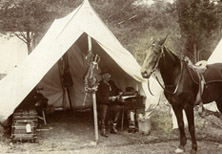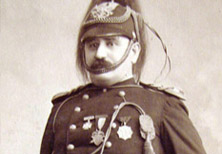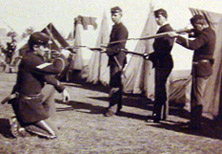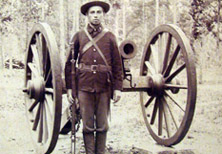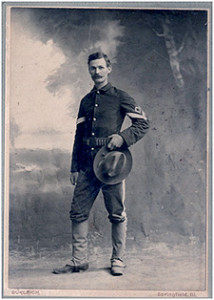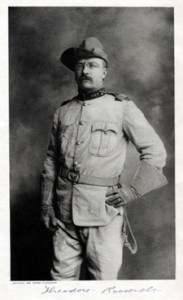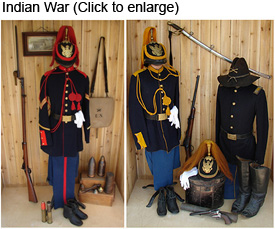Uniforms & Accoutrements
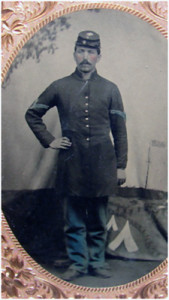 Military uniforms had many changes as it evolved through the years. During the Civil War the strongest foreign influence on Union Army apparel was exerted by France, due to their reputation for military excellence and high style. The regulations of 1858 and 1860 established the uniform that defined the Union soldier. The Army Hat in black felt with appropriate branch insignia; the frock coat with branch piping for foot
Military uniforms had many changes as it evolved through the years. During the Civil War the strongest foreign influence on Union Army apparel was exerted by France, due to their reputation for military excellence and high style. The regulations of 1858 and 1860 established the uniform that defined the Union soldier. The Army Hat in black felt with appropriate branch insignia; the frock coat with branch piping for foot 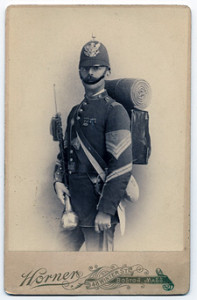 troops, uniform jackets with branch colored lace for mounted troops, and sky blue trousers. After the Civil War Dress uniforms followed the elaborate Prussian style uniform through the Victorian era. The 1872 regulations acknowledged a distinctive uniform for the field and another for ceremonial occasions. Field uniforms, because of the climate and environmental conditions in the different areas across the U.S., changed partially through the solicitation of comments and suggestions from the soldiers. From the end of the Civil War up to the Spanish American War a number of changes were made to the uniforms. During this period there was a considerable lack of uniformity in Army clothing, particularly the field uniform. By the Apache Campaign of the 1880's the Army had become far stricter in requiring that the proper uniform be worn in the field.
troops, uniform jackets with branch colored lace for mounted troops, and sky blue trousers. After the Civil War Dress uniforms followed the elaborate Prussian style uniform through the Victorian era. The 1872 regulations acknowledged a distinctive uniform for the field and another for ceremonial occasions. Field uniforms, because of the climate and environmental conditions in the different areas across the U.S., changed partially through the solicitation of comments and suggestions from the soldiers. From the end of the Civil War up to the Spanish American War a number of changes were made to the uniforms. During this period there was a considerable lack of uniformity in Army clothing, particularly the field uniform. By the Apache Campaign of the 1880's the Army had become far stricter in requiring that the proper uniform be worn in the field. 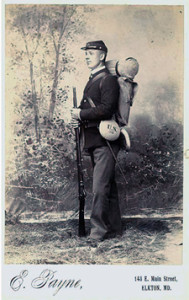
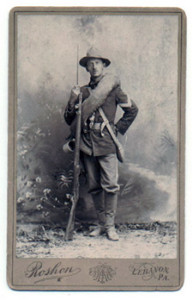 In December 1883 the campaign hat was changed from black to drab with a brass circular vent centered on each side of the crown. The specifications were changed again in February 1889 with the brass vents being replaced by holes punched in each side of the crown in a snowflake pattern. The latter pattern was the type worn during the Span-Am War. A new forage cap introduced in 1895 was similar to the caps worn by firemen and train conductors , and did not find favor with the troops. At the start of the Spanish American War in 1898, the Army adopted a khaki cotton field service uniform based on a British pattern but because of production problems were not issued prior to troop deployment. In June of 1898, issue of the dress uniform was suspended.
In December 1883 the campaign hat was changed from black to drab with a brass circular vent centered on each side of the crown. The specifications were changed again in February 1889 with the brass vents being replaced by holes punched in each side of the crown in a snowflake pattern. The latter pattern was the type worn during the Span-Am War. A new forage cap introduced in 1895 was similar to the caps worn by firemen and train conductors , and did not find favor with the troops. At the start of the Spanish American War in 1898, the Army adopted a khaki cotton field service uniform based on a British pattern but because of production problems were not issued prior to troop deployment. In June of 1898, issue of the dress uniform was suspended.
In December 1883 the campaign hat was changed from black to drab with a brass circular vent centered on each side of the crown. The specifications were changed again in February 1889 with the brass vents being replaced by holes punched in each side of the crown in a snowflake pattern. The latter pattern was the type worn during the Span-Am War. A new forage cap introduced in 1895 was similar to the caps worn by firemen and train conductors , and did not find favor with the troops.
Museum Examples
(You can enlarge the Unifom pictures by clicking on them)
Head Gear

Accoutrements
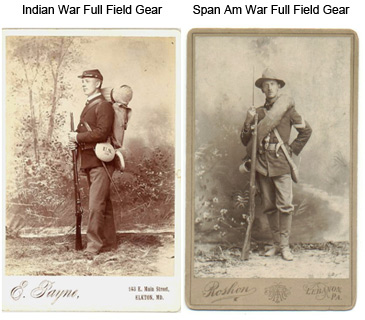 Like the Uniforms that had many changes, so did the Accoutrements.
Like the Uniforms that had many changes, so did the Accoutrements.
In 1866 Muskets were converted and from then on all weaponry fired cartridges with soft copper cases that required protection from denting and verdigris. That change then freed the soldier from worry about the fragility and sensitivity to moisture of the old paper cartridges and the easy loss of percussion caps. This change caused a domino effect in the design of ammunition cases. Early modification examples, to save money, were fleece lining sewn into the cartridge boxes and bored wooden block inserts for either the tin liners or the box cavity itself. The period following the Civil War offered a tremendous variety of cartridge pouches, boxes and carbine sockets and boots.
Once changing to cartridge ammunition, powder flasks were substituted to cartridge cases and no longer a part of standard accoutrements.
While the saber remained a primary piece of equipment for the cavalry and mounted artillery throughout the Civil War, the infantry use of swords became largely decorative and restricted to officers and non-commissioned officers about mid Civil War.
Museum Examples



